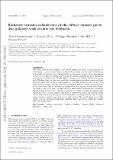Files in this item
Radiative transfer calculations of the diffuse ionized gas in disc galaxies with cosmic ray feedback
Item metadata
| dc.contributor.author | Vandenbroucke, Bert | |
| dc.contributor.author | Wood, Kenneth | |
| dc.contributor.author | Girichidis, Philipp | |
| dc.contributor.author | Hill, Alex S. | |
| dc.contributor.author | Peters, Thomas | |
| dc.date.accessioned | 2018-05-17T15:30:05Z | |
| dc.date.available | 2018-05-17T15:30:05Z | |
| dc.date.issued | 2018-05 | |
| dc.identifier | 253109316 | |
| dc.identifier | 1bc7313c-d262-4e9e-ab59-527cad864b0c | |
| dc.identifier | 000430944100079 | |
| dc.identifier | 85045901699 | |
| dc.identifier | 000430944100079 | |
| dc.identifier.citation | Vandenbroucke , B , Wood , K , Girichidis , P , Hill , A S & Peters , T 2018 , ' Radiative transfer calculations of the diffuse ionized gas in disc galaxies with cosmic ray feedback ' , Monthly Notices of the Royal Astronomical Society , vol. 476 , no. 3 , pp. 4032-4044 . https://doi.org/10.1093/mnras/sty554 | en |
| dc.identifier.issn | 0035-8711 | |
| dc.identifier.other | ORCID: /0000-0001-7241-1704/work/50167443 | |
| dc.identifier.uri | https://hdl.handle.net/10023/13383 | |
| dc.description | BV and KW acknowledge support from STFC grant ST/M001296/1. PG acknowledges support from the DFG Priority Program 1573 Physics of the Interstellar Medium as well as funding from the European Research Council under ERC-CoG grant CRAGSMAN-646955. | en |
| dc.description.abstract | The large vertical scale heights of the diffuse ionized gas (DIG) in disc galaxies are challenging to model, as hydrodynamical models including only thermal feedback seem to be unable to support gas at these heights. In this paper, we use a three-dimensional Monte Carlo radiation transfer code to post-process disc simulations of the Simulating the Life-Cycle of Molecular Clouds project that include feedback by cosmic rays. We show that the more extended discs in simulations including cosmic ray feedback naturally lead to larger scale heights for the DIG which are more in line with observed scale heights. We also show that including a fiducial cosmic ray heating term in our model can help to increase the temperature as a function of disc scale height, but fails to reproduce observed DIG nitrogen and sulphur forbidden line intensities. We show that, to reproduce these line emissions, we require a heating mechanism that affects gas over a larger density range than is achieved by cosmic ray heating, which can be achieved by fine tuning the total luminosity of ionizing sources to get an appropriate ionizing spectrum as a function of scale height. This result sheds a new light on the relation between forbidden line emissions and temperature profiles for realistic DIG gas distributions. | |
| dc.format.extent | 13 | |
| dc.format.extent | 2384139 | |
| dc.language.iso | eng | |
| dc.relation.ispartof | Monthly Notices of the Royal Astronomical Society | en |
| dc.subject | Radiative transfer | en |
| dc.subject | Methods: numerical | en |
| dc.subject | Cosmic rays | en |
| dc.subject | Galaxies: ISM | en |
| dc.subject | Galaxies: structure | en |
| dc.subject | QB Astronomy | en |
| dc.subject | QC Physics | en |
| dc.subject | DAS | en |
| dc.subject.lcc | QB | en |
| dc.subject.lcc | QC | en |
| dc.title | Radiative transfer calculations of the diffuse ionized gas in disc galaxies with cosmic ray feedback | en |
| dc.type | Journal article | en |
| dc.contributor.sponsor | Science & Technology Facilities Council | en |
| dc.contributor.institution | University of St Andrews. School of Physics and Astronomy | en |
| dc.identifier.doi | https://doi.org/10.1093/mnras/sty554 | |
| dc.description.status | Peer reviewed | en |
| dc.identifier.url | https://arxiv.org/abs/1802.07749 | en |
| dc.identifier.grantnumber | ST/M001296/1 | en |
This item appears in the following Collection(s)
Items in the St Andrews Research Repository are protected by copyright, with all rights reserved, unless otherwise indicated.

